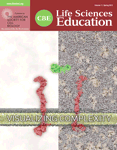Visualizing Protein Interactions and Dynamics: Evolving a Visual Language for Molecular Animation
Abstract
Undergraduate biology education provides students with a number of learning challenges. Subject areas that are particularly difficult to understand include protein conformational change and stability, diffusion and random molecular motion, and molecular crowding. In this study, we examined the relative effectiveness of three-dimensional visualization techniques for learning about protein conformation and molecular motion in association with a ligand–receptor binding event. Increasingly complex versions of the same binding event were depicted in each of four animated treatments. Students (n = 131) were recruited from the undergraduate biology program at University of Toronto, Mississauga. Visualization media were developed in the Center for Molecular and Cellular Dynamics at Harvard Medical School. Stem cell factor ligand and cKit receptor tyrosine kinase were used as a classical example of a ligand-induced receptor dimerization and activation event. Each group completed a pretest, viewed one of four variants of the animation, and completed a posttest and, at 2 wk following the assessment, a delayed posttest. Overall, the most complex animation was the most effective at fostering students' understanding of the events depicted. These results suggest that, in select learning contexts, increasingly complex representations may be more desirable for conveying the dynamic nature of cell binding events.



